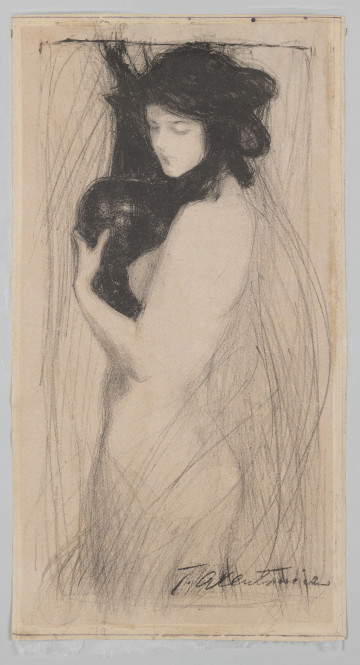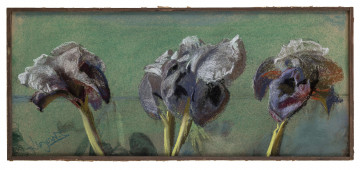
Woman with a vase
1903
National Museum in Lublin
Part of the collection: Religious scenes
The nasturtium motif in the work of Stanisław Wyspiański, one of the most original Young Poland artists, appeared in the painting decoration of the Franciscan Church in Kraków. In realising the commission, Wyspiański used, among other things, stylised examples of native flora combined with a geometrised background. Floral motifs played an important role in Wyspiański's artistic oeuvre; they appeared as a background or as a complement to his pastel portraits or stained glass windows, as well as leading, independent elements in his designs for wall paintings. Drawing inspiration from nature, he also used floral forms in his dramas and in the pages of "Życie", which he took over as artistic director. They often depicted wild field flowers, taken from the artist's Zielnik [The Herbarium], which he regarded as one of the most important elements of the native landscape. Wyspiański worked on the polychrome project between 1895 and 1897. In 1897, he supplemented the geometric decoration of the walls in the chancel, the transept and the western bay of the church with floral motifs - roses, nasturtiums and pansies. The composition in question was created in 1903, several years after the completion of work on the polychrome, as an authorial repetition of the project found in the National Museum in Kraków (1897) inverted and extended with a strip of geometrical ornamentation. Nasturcje [Nasturtiums] bear typical features of Wyspiański's style with a dominant flat colour patch and a clear contour. The soft, flexible line of intertwined stems, resulting from the morphology of the plant, corresponded to his temperament, reflecting at the same time the natural shape and structure of plants. Like other floral motifs that came from the artist's hand, Nasturcje [Nasturtiums] demonstrate the virtuosity with which he reproduced nature and stylized it for his projects. The perfect sense of composition, consisting of contrasting, seemingly distant elements, such as the decorative arrangement of a tangled stem, the delicate line of flowers, and the austere, geometric ornamentation of the background corresponding to the veined divisions of the heart-shaped leaves, made it possible to achieve balance and logical order in the representation. The dynamism of the floral motif is enhanced by the colours of the vivid patches of colour which characterise the whole painting decoration of the Franciscan church.
Anna Hałata
Author / creator
Dimensions
cały obiekt: height: 154 cm, width: 113,5 cm
Object type
drawing
Technique
pastel
Material
paper
Creation time / dating
Creation / finding place
Owner
The National Museum in Lublin
Identification number
Location / status

1903
National Museum in Lublin

1910
National Museum in Lublin

XIX/XX century
National Museum in Lublin
DISCOVER this TOPIC
Museum of King Jan III's Palace at Wilanów
DISCOVER this PATH
Educational path